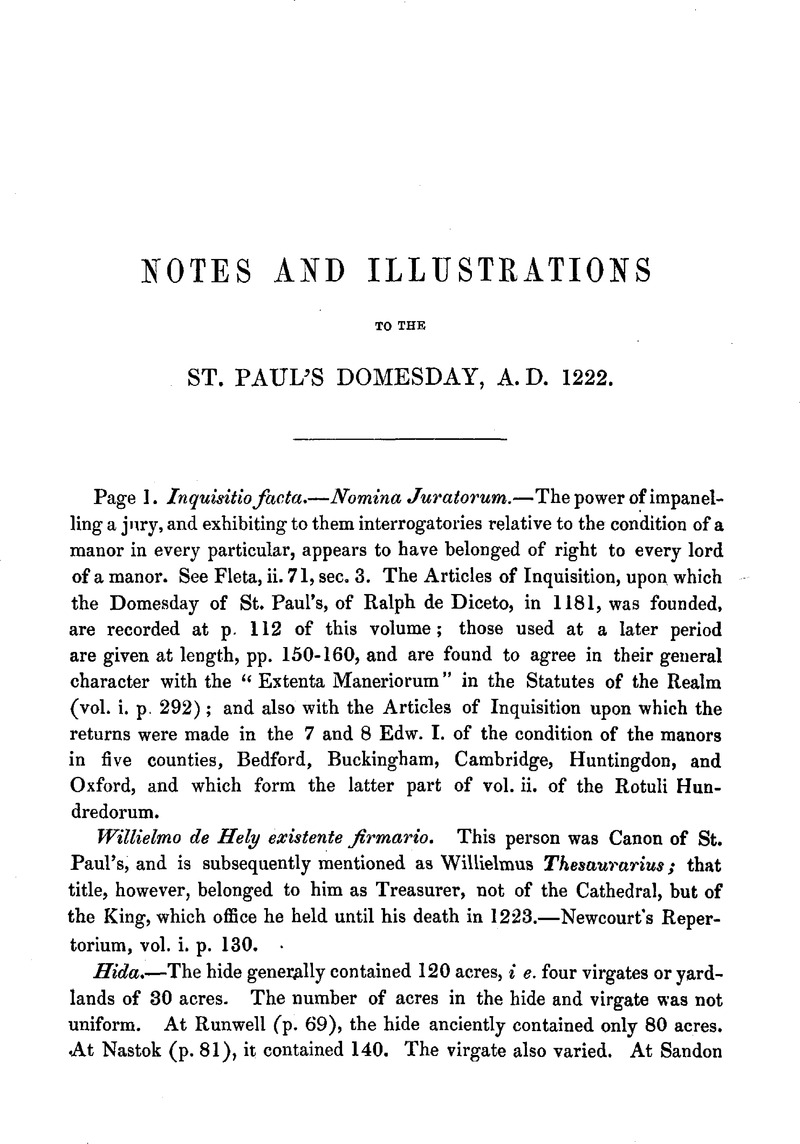No CrossRef data available.
Published online by Cambridge University Press: 23 February 2010

page lxiii note * The references I. 145, I. 97, &c. denote the folios of the Book marked by the letter I. now remaining in the Archives of the Cathedral, which contains the Survey or Inquisition of the Manors made by Dean Baudake, and which will be frequently mentioned as the Inquisition of A.D. 1279.
page lxiv note * In the proceedings upon a Placitum de quo Warranto in the time of Edward III. against the two prebendaries of Cadington, a charter of Edward II. was produced reciting and confirming a charter of the Conqueror which gave to the church of St. Paul's the fullest rights in all their laDds.—Placita de Warranto, pages 40, 41.
page lxvii note * The lexicographers are in doubt as to the root of the word “averare.” The verb “auejnan” occurs in the Rectitudines Singularum Personarum (Laws of England, vol. i. p. 132.)
page lxxvii note * In the district around Iglau in Moravia, an old burial ground is called “Saaracker,” the word Saar or Sar meaning a ghost. The editor is indebted to a friend for this illustrative conjecture.
page xcvi note * In other leases, those of Adulvesnasa (pp. 131, 132), of Sandun (p. 134), of Ardeleia (pp. 136, 137), the buildings of the manor, house are mentioned, but without the accurate account of the dimensions as here given.
page xcvii note * “Habebunt unam tinam cum cervisia.” I. 132.
“Asportavit qnandam tinam plenam piscibus.” Rot. Hund. II. 254.
page xcvii note † Unum molendinum manuale pro sinapio (a mustard-mill), precium vi d. I. 153.
page xcix note * The Trisantia appears to have been that part of a hall or chamber, which was separated by a screen, and which might form either an ante-chamber or a recess. In 1283 the manor-house of Sutton had “unam cameram divisam cum trisantiis ad clericos.” (I. 24.)
page xcix note † The Solarium or sollar was a room or chamber at the top of the building. “Solarium. Locus editus in domo, soli expositus, ubi apricari solebant.” (Facciolati.) The character of the solarium is more clearly shown by the definition in the Catholicon of J. de Janua: Solarium, quasi solaurium, quia soli et aeri vel auræ patent.
page cvi note * Placita de quo Warranto, Com. Bedford, 4 Ed, III. 1316, p. 43. Oliverus de Casnerle summonitus fuit ad respondendum domino Regi de placito quo warranto clamat habere visum franciplegii in manerio suo de Chalnesterne.
Et Oliverus per Henricum de Flamville atturnum suum venit et dicit, quod ipse et omnes supradictum manerinm tenentes, a tempore quo non extat memoria, seisiti fuerunt de prædicto visu, tanquara pertinente ad manerium prædictum, tenendo in forma subscripta viz. quod quolibet anno, die quæ vocatur le Hockeday, omnes infra dominium suum residentes ibidem conveniant, et per eosdem inquiratur, quales et qnanti residentium prædictorum qui in decenna ponendi aunt et non ponuntur, et etiam de nominibus eorum qui eodem die non comparuerunt ibidem. Ita quod de quolibet comparente unus denarius capiatur, et quod absentes amercientur; et similiter si quis ætatis duodecim annorum extra decennam inveniatur, quod tune ille sub cujus manupastu fuerit, amercietur pro eodem; et dicit ulterius, quod ipse reddit domino regi duos solidos pro visu tenendo in forma predicta.
Rotuli Hundredorum, vol. ii. p. 219, Com. Sussex: Hundred, de Tottenore, 30 E. I.
In a return to the Article of Inquisition, Qui pro potestate officii sui aliquos malitiose occasionaverint et per hoc extorserint terras, redditus, et alias præstationes &c. Dicunt, quod Ricardus de Pevensei, baillivus honoris de Pevensei, amerciat capitales plegios cum tota decenna, eo quod aliquis de decenna sit absens causa peregrinationis vel causa servientiæ in longinquis partibus, et ad prædictum lagheday non venerit, licet per totum hundredum testificeter bonus et fidelis, qui absens eat.
The following entries of payments by the decenna appear in accounts rendered to the Exchequer by the Sheriff of Herts. Placita de quo Warranto, 4 Ed. III. p. 16.
In rotulo xo R. H. In Essex—Hertford. Vicecomes reddit compotum de dimidia marca de decenna Galfridi Clerici de Oppyng et Rogeri Parcarii pro fuga eorum. Et de dimidia marca de decenna Rogeri fil' Warini Aigitivi.
In rotulo xii. R. H. Yicecomes reddit compotum de 1 marca de francoplegio Richardi Pocher pro fuga Willielmi.
page cviii note * “Idem forestarii colligunt garbas per autumnum infra metas et buudas prædictas in com. Wiltes, et nihilominus post autumnum similiter metu extorquent communiter a populo juxta illam chaciam manente bladum trituratum ad braciandum scotalia sua, et postea per compulsionem illorum veniunt ad scotalia sua.” Rot. Hund. co. Wilts, vol. ii. p. 249.
page cx note * In Yorkshire irregular pieces of land are called “gares.” See the Glossary of the Farmer's Book of H. Best, published by the Surtees Society, 1857.
page cxvi note * In the Life of Offa (Matt. Paris, pp. 29, 31), it is stated that Offa's original grant was that of one silver piece from those who possessed cattle of the value of thirty silver pieces. It is also stated, that, when that monarch granted Peter-pence from his whole kingdom, he reserved the Peter-pence from the lands of St. Alban to the use of the Abbey. These lands in later times included the parishes which formed the hundred of Cashio, and the Abbatial archdeaconry of St. Alban's, in the county of Herts.
page cxxii note * In Book I. 135, 136, we read, “Warinus de Bassingbourne tenet unam carncam terræ continentem ixxx acras terræ arabilis.” And in I, 136, “Warinus de Brantone tenet unam carucam continentem viixx acras cum prato et bosco.”
page cxxiii note * It is however probable that such tenants of a manor as dwelt there, hut were liable to services in other places, were termed “forinseci.” In the Rot. Hund. Co. Oxon. the services due at the Court of the Hundred by lords of manors are distinctly noted, as the “forineecum.” e.g. Ennestan Foriosecum, fol. ii. p. 740, &c.